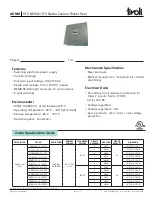
V A L A V I O N I C S L T D
I N S 4 2 9 I N T E G R A T E D N A V I G A T I O N S Y S T E M
I N S T A L L A T I O N A N D O P E R A T O R ’ S M A N U A L
Revision 3
Page 23 of 27
March 2013
9.6.2
OUTPUT MESSAGES
RESET STATUS
This message is sent to indicate to the host that the INS 429 / COM 2000 is running and ready to accept
data on the serial port. It will be sent once upon startup and when requested by the host.
Message format:
“V”………..Message class. This is a VHF NAV message.\
“20”………Message identifier.
Example message:
$PMRRV20<chksm><CR><LF>
INS 429 is running and ready to accept serial input.
CDI, GSI, AND RELATED FLAGS
This message outputs the current values of the CDI, GSI, and their related flags. After power up this
message will be output at a 10 Hz rate.
Message format:
“V” ..................... Message class. This is a VHF NAV message.
“21” .................... Message identifier.
cc........................ CDI deflection. An eight-bit value indicating the amount of deflection of the
CDI needle, represented as two encoded hex
3
digits. The CDI deflection is a
twos complements signed integer in the range of –100 to 100. –100 indicates full
left deflection, 0 indicates no deflection, and 100 indicates full right deflection.
gg ....................... GSI deflection. An eight-bit value indicating the amount of deflection of the GSI
needle, represented as two encoded hex
XX
digits. The CDI deflection is a twos
complement signed integer in the range of –100 to 100. –100 indicates full
deflection upwards, 0 indicates no reflection, and 100 indicates full deflection
downwards.
ff......................... Flags. Eight bits for HNAV and VNAV related flags, represented as two
encoded hex digits.
Bit 1 (1sb) Back Course enable (1 = enabled)
Bit 2
Localizer detect (1 = using localizer)
Bit 3
FROM flag (1 = From)
4
Bit 4
TO flag (1 = To)
Bit 5
GSI superflag (1 = valid)
Bit 6
GSI valid (1 = valid)\
Bit 7
NAV superflag (1 = valid)
Bit 8 (msb) NAV valid (1 = valid)
Example message:
$PMRRV21817??:<chksm><CR><LF>
3
Encoded Hex: each character consists of 4 bits of data placed in the low order 30h. For example, the 8-bit
value of 5Fh would be encoded as two characters with values of 35h and 3Fh, which map to the ASCII characters
“5” and “?” respectively.
4
The TO and From flag can not both be 1, indicating that they are both valid. They can both be zero, indicating that
neither is valid. This situation will occur whenever the receiver determines that it is within the “cone of confusion”
directly over the VOR, or when no signal is being received.




































